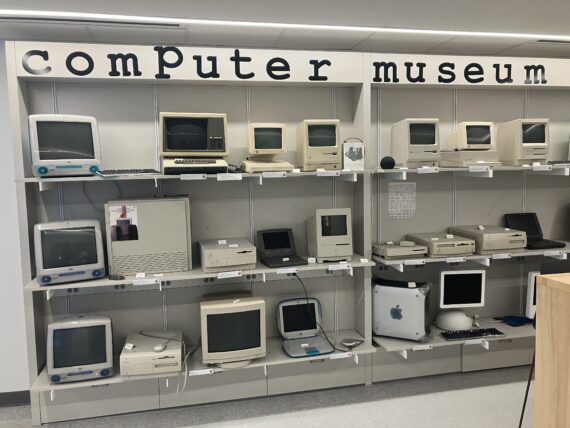Tucked away in the divider hallway between the library and the Discovery Center lies a relic of the past that is often overlooked by Wheaton students. As people meander to and from class, they walk right past decade-old computers that are still functioning, and retro video game emulators that can run dozens of classic titles. A tribute to the history of in-home machine entertainment systems, the Wheaton Computer Museum and Gaming Station stand as a way for professors and staff to reconnect with the devices of their youth, as well as a way for students to learn about the predecessors of their Xboxes and Dell laptops.

Some of the computers on display currently in the museum
In charge of the space is Professor Mark LeBlanc of the Computer Science, Math, and Physics department. He has overseen the museum for years, including when it underwent a complete overhaul during the Discovery Center renovation project that took place during the years that preceded the COVID-19 pandemic. “It was a lot of work actually,” said Professor LeBlanc of the museum’s renovation. “We had to break down the entire museum and store it for a year. What we did is we left them [the old computers] in their racks, and we shrink-wrapped them.” This protective measure kept the devices safe from the dust that accumulated as they sat in storage waiting to be put back out on display.
It was also during this time that the space received the Raspberry Pi micro-computers that powered the current Gaming Station. The devices were set up by Nick Rauer, Wheaton’s Manager of Networking and Telecommunications, during the summer of the renovation project. Previously, the space had featured actual retro gaming consoles, but they were limited in their game selection, and their longevity was in question. Professor LeBlanc recalled when Mr. Rauer first floated the idea of instead setting up Raspberry Pi’s as game emulators in the Gaming Station, which would be more durable and easier to repair than old consoles themselves. “He came down [to the Computer Museum], and he said ‘I can set up this other thing’, and we thought ‘Okay, that’s great.’ Next thing you know, we got two new flatscreens with the reconstruction, and he said, ‘I’m donating two Raspberry Pi’s.’” While the machines still technically belong to the college, Mr. Rauer was the one who repurposed them into retro game emulators, and he continues to upkeep and upgrade them to this day.
When the plans for a campus renovation were first proposed, the Computer Museum and Gaming Station were not initially included. There was some consideration of tearing down the museum entirely to make space for more classrooms. Professor LeBlanc and Mr. Rauer petitioned for the Computer Museum to remain and receive an overhaul, but they were initially met with resistance. Then, in a meeting one day, things changed. “Someone who is no longer here actually spoke up at a meeting,” said Professor LeBlanc, “and said: ‘Look, it’s not going to cost a lot just to include this extra space in the renovation.’” He cited this moment as a turning point towards preserving the museum and helping it grow into what it is today, an area that not only includes retro computers and gaming setups but also includes a faculty writing center and a computer science lab.
Professor LeBlanc attributed the upgrades to part of the reason why the hallway is even in use at all. Years ago, the door that connected the Stacks level of the library to the Discovery Center was kept locked. However, after the renovations, it was agreed to keep the door open so that faculty and students alike could freely pass through the space that connected the two buildings. “I like to think that the Computer Museum being such a nice presence helped the librarians agree, ‘Okay, we can keep that door open,’” commented Professor LeBlanc.
The space has continued to evolve to increase interactivity and community engagement. Currently, there is an Alexa system set up that when prompted, can recite a brief history of any old computer it is asked to describe. One can simply sit down at the table in the middle of all the machines, cue the Alexa, and receive a mini-guided tour through the museum. In addition, there is a monitor that displays various slideshows related to the history and the current state of computer science. At the moment, it shows a presentation about ten women from underrepresented and minority groups who are excelling in the modern-day computing field.

This vertical screen scrolls through a PowerPoint about women excelling in the computing field
So next time you’ve got a few minutes between classes, consider stopping by the Computer Museum for a brief journey back to the past. Students, faculty, and visitors alike are sure to learn something new, rediscover something old, or perhaps even get a sense of the future. As Professor LeBlanc puts it, “It [the Computer Museum] shows people where we’ve come from. We’re often asked to wonder about what it’s going to be like in five years, and it really helps to have a space where you can actually look back and see where we were five years ago, and five years before that, and realize this is not linear change, it’s really exponential.”